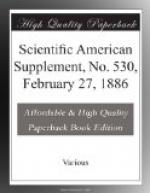JOSEPH C. GORDON, M.A.,
Professor in the National College, Washington, D.C..
* * * * *
FRUITS AND SEEDS FOR DRESS-TRIMMING.
The use of natural flowers for decorating the person is instinctive among certain peoples, and a question of fashion among others. It is in Oceanica especially that this taste seems to be nationally developed, and from the narrative of Cook we know that the Tahitian belles use in their toilet the perfumed flowers of the pua and tiare (Carissa grandis and Gardenia Tahitensis), whose dazzling whiteness renders still more marked the ebony blackness of their wealth of hair.
In Europe this custom is traditional in many countries. Women of fashion scarcely ever appear at a soiree or ball without wearing a camellia or an exotic orchid on their breast or in their head-dress, and so, too, gentlemen of “high life” do not go out without a boutonniere of white violets or Cape jasmine.
But natural flowers, being ephemeral, were once replaced in the toilets of ladies by artificial ones. The artificial flower industry originated in China, and from thence passed into Italy and afterward into France. In course of time people got tired of artificial flowers for decorative purposes, and then imitation fruits made their appearance, and were worn in the toilets of dowagers and mothers of families.
Now that fashion, that tyrant born of dressmakers, milliners, and tailors of renown, obliges us to clothe ourselves according to accepted models, the kaleidoscope no longer suffices to find the most varied designs and most fantastic cuts for garbs or ornament.
In recent years pleasing objects have been borrowed from the animal kingdom, such as small birds and quadrupeds, and insects with brilliant colors and of strange forms. What formerly would have been a repulsive object (such as a great longicorn or beetle) is worn with ease by the belles of our time. The use of such objects of natural history, however, has been about confined to the decoration of head-dresses or the manufacture of jewelry.
[Illustration: FIG. 1.—DRESS TRIMMINGS OF FRUITS AND SEEDS. 1. Seeds of Casuarina and fruit of alder. 2. Acorn cup, involcure of beech, and pod of medick. 3. Fruit of Eucalyptus, cups of acorns, Job’s tears, and cones of cypress.]
As the need of creating new models is always making itself felt, one ingenious manufacturer, Mr. Collin, has turned toward the vegetable kingdom, and brought out an elegant and original style of dress-trimming made of certain indigenous and exotic fruits and seeds that no one would ever have thought of using for such a purpose. Instead of pendants made of wood and covered with silk or velvet, Mr. Collin uses dry fruits or seeds, which he has previously dyed, gilded, or silvered.
[Illustration: FIG. 2.—DRESS TRIMMINGS OF FRUITS AND SEEDS. 4 and 5. Fruit of alder. 6. Fruit of Casuarina. 7. Fruit of Arbutus. 8. Fruit of Casuarina.]




